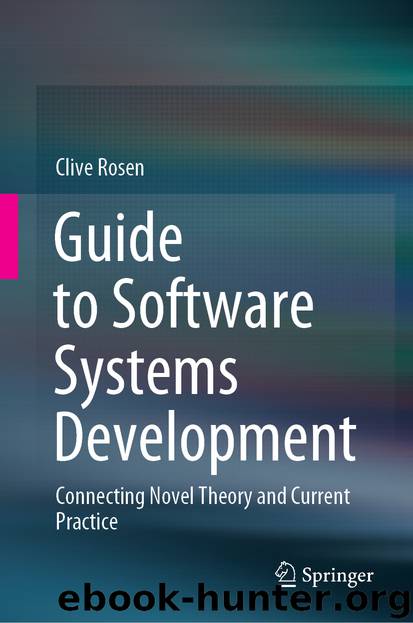Guide to Software Systems Development by Clive Rosen

Author:Clive Rosen
Language: eng
Format: epub
ISBN: 9783030397302
Publisher: Springer International Publishing
5.9 Informatics
More recently the balance of whether to maintain an in-house SSD capability has shifted more in the direction in-house arrangements. This is due to the emergence of the potential of data analytics. The example of Tesco cited above may have been the start of the data revolution, but the power of data analytics has become generally acknowledged. Even small organisations have the capacity for improving their efficiency using data collected from within the organisation or from customers. This is not dependent on a loyalty card scheme. Indeed, arguably, almost all organisations are now information management businesses.
To benefit from data collection, data has to be transmogrified into information, and this depends on understanding the data in relation to the organisation. The better the data analysts understand the organisation and the business of the organisation itself, the better use they can make of the data. Turning data into information is not just a matter of number crunching. Real insight into the numbers only comes with insight into the business. This makes it more important that the organisation has full control over the data it collects and the data it is able to collect. This means it is more important that it has control over the software system that collects that data.
If, for example, a sandwich shop has an idea that men buy more chicken sandwiches and women buy more tuna sandwiches. If more women tend to come in on Monday after their palates class, and men on Fridays after a pre-weekend gym workout,7 it would only be possible to confirm this insight if the data collection system collected data on which sandwiches were sold on what days to whom. An apparently small amendment to the database may incur a significant development cost if no customer data is currently collected, but would cost very little if all that is required is an additional gender field to an existing customer table. Knowledge of, and the ability to change the database enables development decisions to be taken quickly. Having to request changes from a third party slows down both the decision making and the implementation, and probably increases the cost. One insight often leads to another. One system change therefore often leads to another, so the change requirements accelerate. There are good reasons for maintaining control over the system and its rate of change as entropy can set in. There is a marginal increase in the difficulty of making a change to a system with each change that is made. Eventually, further change becomes unsustainable and the system must be replaced. Knowledge of the legacy system then becomes essential to keeping it running longer, designing the new system and smoothing the transition from the old to the new system. If that knowledge resides with a third party organisation, it may not be accessible to the client organisation. This might well be another headache for the IT aware CEO of a small, growing business.
Download
This site does not store any files on its server. We only index and link to content provided by other sites. Please contact the content providers to delete copyright contents if any and email us, we'll remove relevant links or contents immediately.
Hit Refresh by Satya Nadella(9038)
The Compound Effect by Darren Hardy(8808)
Change Your Questions, Change Your Life by Marilee Adams(7635)
Nudge - Improving Decisions about Health, Wealth, and Happiness by Thaler Sunstein(7615)
The Black Swan by Nassim Nicholas Taleb(7010)
Deep Work by Cal Newport(6880)
Daring Greatly by Brene Brown(6446)
Rich Dad Poor Dad by Robert T. Kiyosaki(6403)
Principles: Life and Work by Ray Dalio(6213)
Playing to Win_ How Strategy Really Works by A.G. Lafley & Roger L. Martin(5922)
Man-made Catastrophes and Risk Information Concealment by Dmitry Chernov & Didier Sornette(5921)
Digital Minimalism by Cal Newport;(5664)
Big Magic: Creative Living Beyond Fear by Elizabeth Gilbert(5614)
The Myth of the Strong Leader by Archie Brown(5425)
The Slight Edge by Jeff Olson(5346)
Discipline Equals Freedom by Jocko Willink(5285)
The Motivation Myth by Jeff Haden(5156)
Stone's Rules by Roger Stone(5026)
The Laws of Human Nature by Robert Greene(4999)
